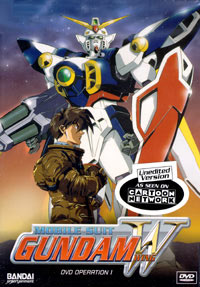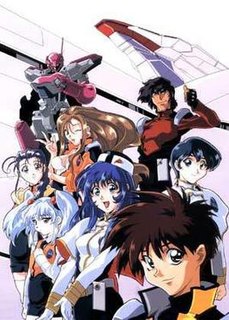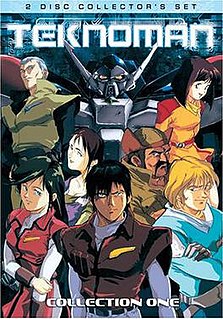Printed media
Manga volumes
The manga release started before the anime broadcast, so that the ending in one medium would not trail too far behind the other. [1] The first chapter, or "mission", appeared in the magazine Monthly Sunday Gene-X in the October 2001 issue [2] (released 19 September 2001); the final chapter was released two months after the airing of the last anime episode, in the December 2002 issue (released 19 November 2002). [3] [4]
The chapters were subsequently released in three compilation volumes which were translated and published internationally. These volumes contain the following chapters and extras. In addition, each publisher may have added certain notes and advertisements in the front and back of the volumes.
- Volume 1
- Artist notes
- Mission 1: "Birth"
- Mission 2: "The Real World"
- Mission 3: "Ally"
- Mission 4: "Awakening"
- Mission 5: "Trust"
- After-word (by Yutaka Izubuchi)
- "Making of RahXephon" comic (an omake)
- Volume 2
- Artist notes
- Mission 6: "Alone"
- Mission 7: "Choice"
- Mission 8: "Decision"
- Mission 9: "Paradise"
- Mission 10: "Destiny"
- "Making of RahXephon" comic 2
- Volume 3
- Artist notes
- Mission 11: "Promise"
- Mission 12: "Prayer"
- Mission 13: "Summer Snow"
- Mission 14: "Destruction"
- Mission 15: "Holy One"
- Final mission: "Over the Rainbow" [lower-alpha 1]
- "Making of RahXephon" last
Available editions
| Publisher | Language | Volume 1 | Volume 2 | Volume 3 |
|---|---|---|---|---|
| Shogakukan [5] | Japanese | ISBN 4-09-157131-X | ISBN 4-09-157132-8 | ISBN 4-09-157133-6 |
| VIZ Media [6] | English | ISBN 1-59116-407-9 | ISBN 1-59116-427-3 | ISBN 1-59116-428-1 |
| Chuang Yi | English | No ISBN listed | No ISBN listed | ISBN 981-260-099-X |
| Madman Entertainment | English | # 1978 | # 1979 | # 1980 |
| Panini Comics (Planet Manga) | Italian | # 37 | # 38 | # 39 |
| Panini Comics (Génération Comics) | French | ISBN 2-84538-230-8 | ISBN 2-84538-284-7 | ISBN 2-84538-322-3 |
| Panini Comics | German | ISBN 3-89921-557-5 | ISBN 3-89921-558-3 | ISBN 3-89921-677-6 |
| Norma Editorial | Spanish | ISBN 84-8431-853-2 | ISBN 84-8431-854-0 | ISBN 84-8431-855-9 |
| Haksan Publishing | Korean | ISBN 89-529-7302-X | ISBN 89-529-7368-2 | ISBN 89-529-7711-4 |
| M&C Comics [7] | Indonesian | # 1327 | # 1328 | # 1329 |
Novelization
Hiroshi Ohnogi, one of the screenwriters on the TV series, has written a novelization in five volumes. These are published in English by DrMaster.
| Volume | Japanese | English | |||
|---|---|---|---|---|---|
| Release | ISBN | Release | ISBN | ||
| 01 | July 2002 | ISBN 4-8401-0598-7 | 2005-08-25 | ISBN 1-59796-000-4 | |
| 02 | August 2002 | ISBN 4-8401-0615-0 | 2005-12-21 | ISBN 1-59796-001-2 | |
| 03 | October 2002 | ISBN 4-8401-0653-3 | 2006-02-25 | ISBN 1-59796-002-0 | |
| 04 | December 2002 | ISBN 4-8401-0687-8 | 2006-06-25 | ISBN 1-59796-003-9 | |
| 05 | February 2003 | ISBN 4-8401-0719-X | 2006-11-15 | ISBN 1-59796-004-7 | |
Guide books
Two different illustrated guide books have been published.
- RahXephon Bible: Analysis Phase : English : ISBN 1-4139-0026-7, 14 October 2003. Japanese : ISBN 4-04-853518-8, June 2002. Contains information from the 19 first episodes, with summaries of the first 15. It contains episode notes, character pages and brief profiles of staff members.
- RahXephon Complete : Japanese : ISBN 4-8401-1019-0‚ March 2003. Covers all episodes, the OVA, movie and video game; in addition to character and episode guides, it contains longer interviews with staff members and a pair interview with directors Yutaka Izubuchi (RahXephon) and Hideaki Anno ( Neon Genesis Evangelion ); this book is only available in Japanese.
There are also two guide books which go more into details.
- Ryusuke Hikawa : RahXephon Complete Capture [lower-alpha 2] (ラーゼフォン完全攻略, Rāzefon kanzen kōrya ku) : Japanese : ISBN 4-19-861675-2, April 2003. This book contains essays about RahXephon. The author is an anime critic and hosts the Anime Maestro television segment for NHK.
- Bandai: RahXephon Blue Sky Fantasia Official Guide Book [lower-alpha 2] (ラーゼフォン 蒼穹幻想曲 公式ガイドブック, Rāzefon soukyū gensokyoku kōshiki guidebook): Japanese: ISBN 4-7542-2025-0, September 2003. Official guide to the RahXephon video game.
Art books
There are also art books available.
- RahXephon Official Illustration Collection : Japanese : ISBN 4-8401-0744-0, 18 April 2003. Contains illustrations made for magazines, DVD covers, soundtracks and other works, concept art, as well as some images made to appear in the series itself.
- RahXephon Art Works : Japanese : ISBN 4-7973-2316-7, 1 July 2003. Contains more illustrations by Akihiro Yamada. These are mostly character design line drawings, with some location, interior and prop concept art. The book also contains Yamada's DVD cover front images (used in Japan).
Other books
- Chouhei Kanbayashi : RahXephon – The Time Controller [lower-alpha 3] (ラーゼフォン – 時間調律師, Rāzefon – jikan chouritsu shi) : Japanese : ISBN 4-19-905120-1, September 2002. A novel set in the RahXephon universe; written by a veteran, award-winning, science fiction and horror writer.
- Hiroshi Ohnogi : RahXephon – The Dreaming Egg [lower-alpha 2] (ラーゼフォン―夢みる卵, Rāzefon – yumemiru tamago) : Japanese: ISBN 4-8401-1001-8, November 2003. This book contains six short stories, close to novella length, each focusing on past events in the lives of selected characters, like Jin Kunugi, Itsuki and Haruka.













